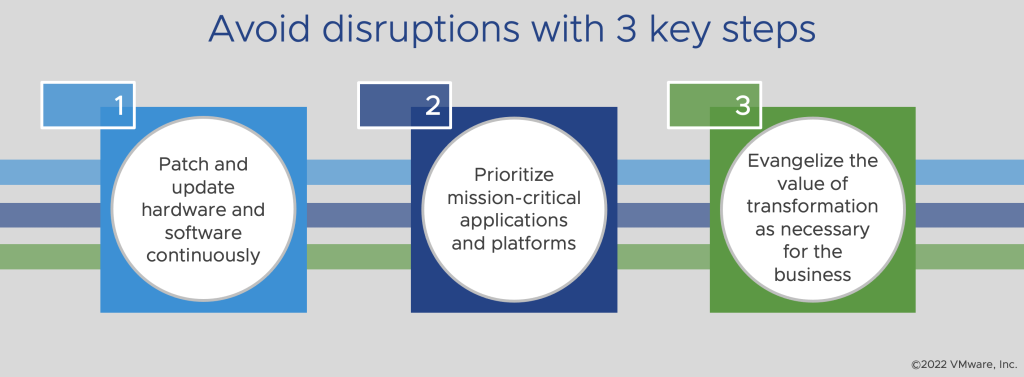By Vijay Kanchi and Clementina Altamirano
This blog is part of a series about the operations pain points that many organizations face as they tackle digital transformation and change management. Our experts provide insights and recommendations based on their decades of hands-on experience and tackle some of the most pressing business and technology pain points.
At heart, Vijay Kanchi is an engineer: “I love to leverage technology as tools for capabilities that allow people to solve business and operational problems. My passion is to bring this together with customer empathy for alignment and success in digital transformations.”
In his almost 30-year career and counting, Vijay has seen technologies and platforms evolve and change and is currently a director of product management within VMware’s Customer Success and Experience professional services organization. He specializes in technology architecture design and alignment with client target states.
Vijay’s recent projects include incorporating site reliability engineering (SRE) and agile services to optimize and scale reliable, secure operations for customers.
A Q&A About Digital Transformation Business Disruptions with Vijay Kanchi
The following are Vijay’s answers to some of the most common pain points around business disruptions during digital transformations.
What are the most common types of business disruptions during digital transformations and what can organizations do about them?
There are three common themes that I see over and over. If organizations can address these, they will have a positive impact on business continuity.
The first disruption is caused by not patching and upgrading infrastructure network and application platforms. Organizations expose themselves to security risks if they don’t keep up with these simple but sometimes time-consuming tasks. Making sure everything is up-to-date is essential to avoiding disruptions.
Second, disruptions can happen when mission-critical applications and platforms are not prioritized. If one of these systems go down, the impact to a business is significant. Mission-critical applications such as a commerce platform or a sales ordering system must have prioritization for updates and user access authentication than less critical software. businesses can tier and classify applications on their infrastructure based on the criticality to their business continuity.
Third, a digital transformation must be viewed by every level in an organization as a catalyst for change that is needed for the business to scale, improve, and lead. A clear mission and reasons for change help motivate everyone to stay the course.

As organizations transform, internal changes can be viewed as disruptions but are necessary to transcend the status quo. What would you recommend as a strategy to implement new tools and processes?
We have a seven-step framework that helps organizations set goals and expectations at the onset of a transformation to drive the conversation around change, disruption, and achieving the desired outcomes.
- Strategic vision: Ensure that all key stakeholders and anyone affected by upcoming changes are involved throughout the transformation and that there is a shared vision of a future state
- Guiding principles: Decide how decisions will be made as new circumstances arise
- Define the future state: Understand what the desired outcomes will be such as reference architectures, process models, and defined services
- Define the current state: Understand the current architectures and models to be able to develop steps towards the future state
- Develop critical path items: Learn about all the dependencies surrounding the technologies, processes, and people involved in the digital transformation including financial constraints
- Create a financial model: Define a model that provides the return on investment of the transformation
- Create a high-level roadmap: Determine the steps needed to get from the current state to the target state
During the COVID-19 pandemic, transformation occurred quickly from necessity and often involved the development and refinement of apps and software that enable curbside delivery and contactless options. What do you see as one of the next technological frontiers for transformations?
Through the pandemic, we saw transformations that sometimes could take years be compressed into three or four months—an enormous reduction in time to execute. That just shows that if you are really motivated, you can really accelerate and I think that now, many executives realize it and are looking to further accelerate change.
One key trend on the horizon is in the availability and launch of 5G networks. This will fundamentally change access to data with higher speeds, greater security, and data fidelity, providing greater momentum for digital transformation.
Many transformations benefit from organizations working with strategic partners to implement changes within desired timeframes and budget. What are some of the criteria organizations should look for in partners for a successful transformation?
There are three attributes organizations should look for in a strategic partner:
- Has this partner gone through and lead similar transformations? There are many unknowns and so much change that arises in a transformation, and experience pivoting and finding solutions that still lead to desired outcomes is invaluable.
- Does this partner have a deep understanding of the technology involved? This is a fundamental and key part of any transformation, and a partner who is not well-versed in an organization’s particular technologies and IT environment will hamper progress.
- Will this partner follow a structured governance model? It’s not enough to have a roadmap: a governance model should account for all vendors and technology platforms within an organization and make sure to track that progress is being made in the time expected.
If you only remember one thing about business disruptions…
If you only remember one thing from this post, it should be this: leveraging a process is essential to minimizing business disruptions during a digital transformation. Follow a framework, do the groundwork, and monitor your progress to stay on track and remedy issues before they interrupt your business continuity and disrupt your bottom line.
Start your transformation journey
If you’re wondering where to start, our strategy and roadmap services or professional services for transformation governance can help. For more operations and digital transformation support, read the other blogs in this series:




